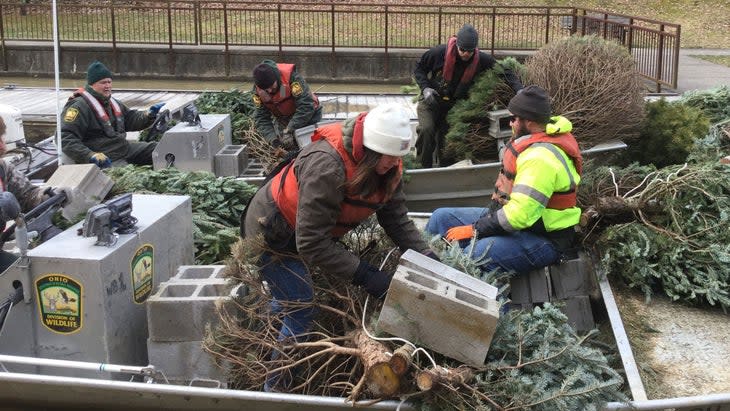Why Is the Forest Service Dumping Christmas Trees into Ohio Lakes?
This article originally appeared on Outside
Do they celebrate Christmas in Davy Jones's locker?
A silly question, perhaps, but it's one that popped into my mind after learning of the annual post-yuletide tradition at Ohio's Wayne National Forest. During the week after Christmas, U.S. Forest Service employees gather hundreds of old Christmas trees, lash them to cinder blocks, and then dump them into Lake Vesuvius, the largest body of water in the park. This year, "sinking day," as it's called, occurred on December 27, and officials sent more than 300 trees to watery graves. They even snapped photos.

"We've been doing this project for several years, at least as long as anyone who works here can remember," said Ashley Kuflewski, a biologist with the Forest Service.
Ohio's Department of Natural Resources did its own Christmas-tree sinking, placing trees in the Appalachian Hills Wildlife Area, West Branch Reservoir, and LaDue Reservoir.
Why send hundreds of Tannenbaum to a lake bed? Officials say the trees become habitat for freshwater fish, while the decomposing bark and needles nourish algae and zooplankton that then feed crawfish, snails, mussels, and other animals. Larger fish like bluegill, panfish, and crappie hide from predators in the sunken branches, allowing pelagic populations to soar. The trees strengthen a lake's ecosystem, which attracts more anglers.
Wayne National Forest's sinking day is hardly an outlier--agencies in Kentucky, Alabama, Texas, South Carolina, and other states also build artificial fish habitat from Christmas trees.
"Fish like to live in places they feel protected," Sarah Chaabane of the South Carolina Department of Natural Resources told the Post and Courier in 2020. "An exposed shoreline might be suitable for fish, but they might need a little encouragement."
In its holiday news release, the Missouri Department of Conservation called submerged Christmas trees "a special gift for fish." The U.S. Army Corps of Engineers invited anglers in Mobile, Alabama, to dump their own trees into waterways, reminding owners to remove all lights, tinsel, and ornaments before heaving a tree overboard. I hope nobody's unopened gift card ended up on a lake bed.
The Virginia Department of Wildlife even tracks the location of these underwater Christmas-tree reefs and maps them out for anglers. In California, the East Bay Regional Park Division shot this video of fish darting about one such reef to show locals what life looks like amid the sunken trees.
Most of the organized Christmas-tree roundups (and sinkings) I read about occur in the days after Christmas, which is to the benefit of those diligent families who immediately pack away the decorations and move on with their lives and schedules. I have yet to find one that works with my family's annual tradition, which is to allow our tree to dry out and shed needles all over our living room well into February.
For exclusive access to all of our fitness, gear, adventure, and travel stories, plus discounts on trips, events, and gear, sign up for Outside+ today.

